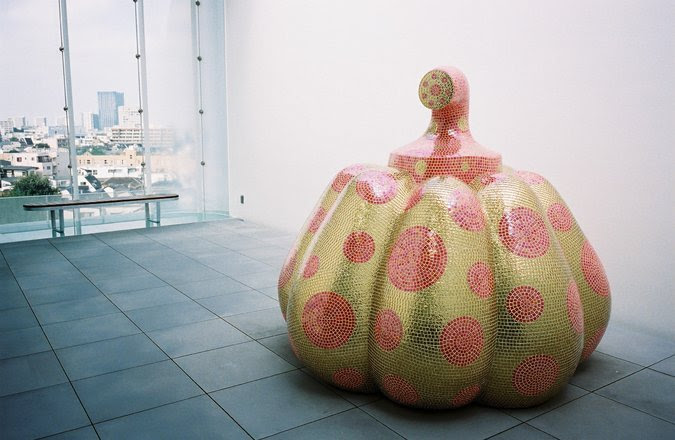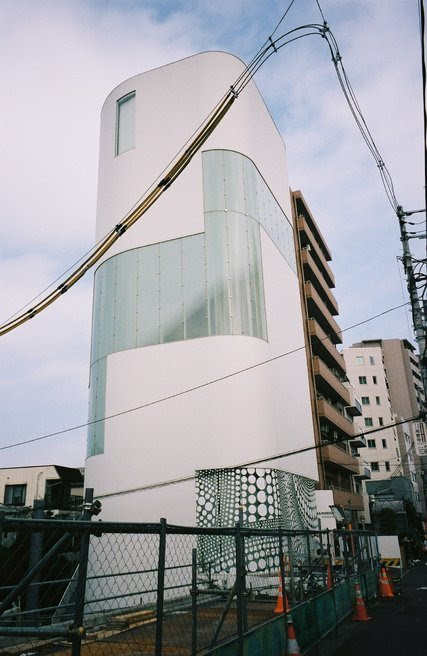정준모
Yayoi Kusama, Queen of Polka Dots, Opens Museum in Tokyo

TOKYO — Even the restrooms are covered in polka dots.
Yayoi Kusama, the celebrated Japanese artist whose compulsively repetitive images have drawn huge crowds and critical acclaim around the world, is opening a museum in Tokyo that could only be hers. The unmistakable touches include large red polka dots and mirrors in the elevators and a bulbous mosaic pumpkin sculpture on the top floor.
“Until now, I was the one who went overseas,” Ms. Kusama, 88, said, sitting in a wheelchair in front of her painting “I Who Have Arrived In The Universe” at a media preview of the Yayoi Kusama Museum on Tuesday. “But I now recognize that there are more people coming to Japan to come to see my work,” she said, reading from a statement in a binder covered in — what else? — red polka dots. “And that is why I decided to establish a place for them to see my work.”
Ms. Kusama, who lived and worked in New York for 16 years at the beginning of her career and was friends with the artists Frank Stella, Donald Judd and Joseph Cornell, with whom she had a relationship, has had retrospectives at the Whitney Museum in New York and the Tate Museum in London.

Yayoi Kusama’s mirrored installation, ”Pumpkins Screaming About Love Beyond Infinity,” at her new museum in Tokyo.
CreditMotohiko Hasui for The New York Times
The museum dedicated to her work, operated by a foundation she created to support the display of her paintings and immersive installations even after her death, officially opens on Sunday. Tickets for timed entry slots went on sale online last month and are already sold out through November.
No surprise there: Last spring, when Ms. Kusama’s work was exhibited at the Hirshhorn Museum and Sculpture Garden in Washington, the show attracted record numbers of visitors who stood in long lines for the chance to spend 20 or 30 seconds in each mirrored room.
In an effort to limit crowds in the new Tokyo museum, only 50 visitors will be admitted at a time for one of four 90-minute slots per day.
The building, designed by the architectural firm Kume Sekkei, stands five stories high in Shinjuku, a residential neighborhood close to Ms. Kusama’s studio and the psychiatric hospital where she has lived voluntarily since 1977.

Designed as five large cubes stacked on top of each other, the museum features galleries with high ceilings, pristine white walls and curved corners. White polka dots are stenciled onto glass panels lining the front of the building. Museum staff declined to say how much it had cost to build.
Ms. Kusama selected all of the art that appears in the inaugural exhibition, “Creation Is a Solitary Pursuit, Love Is What Brings You Closer to Art,” which includes mostly recent work and runs until Feb. 25. Exhibitions will be rotated every six months.
“It will probably be a mecca for Kusama,” said Yasuaki Ishizaka, the former head of Sotheby’s in Japan and now an art adviser. “She is one of the first Japanese — the only Japanese perhaps — who has a really popular worldwide following, whether it’s Asia, Europe or the States, or whether it’s with elderly or younger people.” Ms. Kusama said she creates her works during a process of obsessive concentration and hallucinations.In 2014, one of her works, “White No. 28,” sold for $7.1 million, with premium, at Christie’s.
The new exhibition includes 45 pieces, 16 of which are part of the series “My Eternal Soul” — large, electric-colored acrylic paintings that Ms. Kusama has been working on since 2009 and that were exhibited at the National Art Center in Tokyo earlier this year.



Asked at her studio about the relationship between her psychiatric condition and her art, her handlers suggested the question was “too sensitive.”
But Ms. Kusama insisted on answering. “Since I was 10 years old I have been painting every day,” she said. “And even now there is not a day that I do not paint.” She added, “I still see polka dots everywhere.”
Her goal, she said, sitting in front of two new works in her studio, is to keep going. “I am just trying to struggle, always,” she said. “Art is everything for me and I have been struggling for art.”
She said she frequently hears from museums around the world wanting to stage exhibitions of her work. “I am just trying to concentrate on painting,” she said.
An assistant rolled her back to a table where a large sky-blue canvas rested. Ms. Kusama picked up a small brush from a dish of black acrylic paint, and carried on painting columns of catlike eyes that she had started that morning.
Hisako Ueno contributed reporting in Tokyo.
FAMILY SITE
copyright © 2012 KIM DALJIN ART RESEARCH AND CONSULTING. All Rights reserved
이 페이지는 서울아트가이드에서 제공됩니다. This page provided by Seoul Art Guide.
다음 브라우져 에서 최적화 되어있습니다. This page optimized for these browsers. over IE 8, Chrome, FireFox, Safari